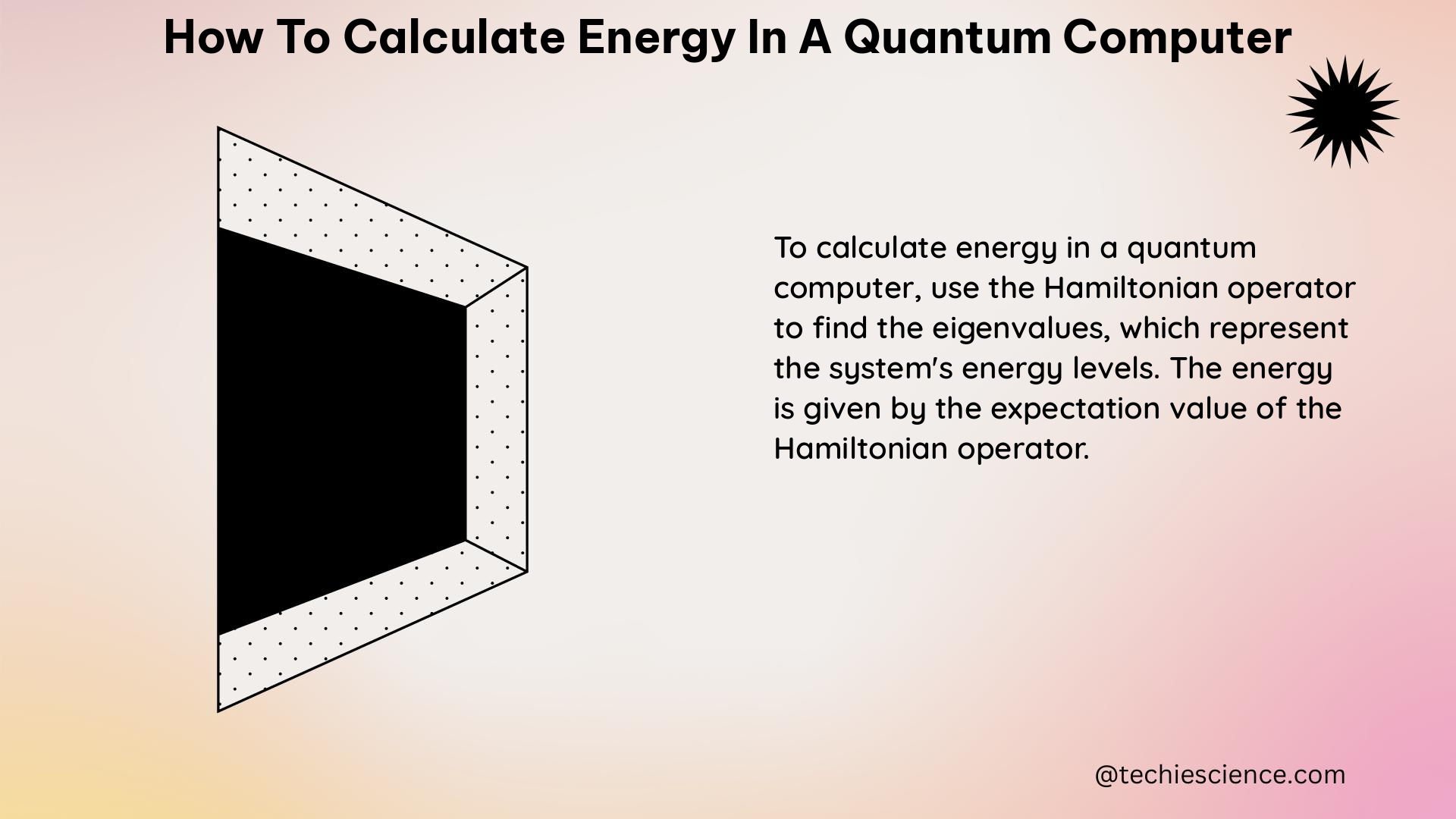Calculating energy in a quantum computer involves advanced techniques and algorithms that leverage the unique properties of quantum mechanics. This comprehensive guide delves into the step-by-step processes, mathematical formulations, and practical applications of energy calculation in the realm of quantum computing.
1. Quantum Self-Consistent Equation-of-Motion Method
The Quantum Self-Consistent Equation-of-Motion (q-sc-EOM) method is a powerful technique used to compute molecular excited states and ionization potentials on a quantum computer. This method involves the following key steps:
- Ground-State Wavefunction Calculation:
- The ground-state wavefunction is calculated using the fermionic ADAPT-VQE (Variational Quantum Eigensolver) method.
- The ADAPT-VQE method employs the generalized singles and doubles (GSD) operator pool.
-
The gradient convergence criterion is set to a threshold of 10^{-3} for all ground-state energy calculations.
-
q-sc-EOM Matrix Elements Evaluation:
- The q-sc-EOM matrix elements are evaluated on a quantum computer.
- This process involves measuring (o^4 × v^4) matrix elements, where
oandvrepresent the numbers of occupied and unoccupied orbitals, respectively. - The matrix is typically sparse, and its size can be reduced using spatial symmetry and spin symmetry.
The q-sc-EOM method provides a systematic and accurate approach to computing molecular excited states and ionization potentials on a quantum computer.
2. Quantum Phase Estimation Algorithm

The Quantum Phase Estimation (QPE) Algorithm is a powerful tool for estimating molecular excitation energies. This algorithm involves the following key steps:
- Quantum Circuit Optimization:
- Optimal parametrized circuits are obtained for every excited state.
-
This is achieved by minimizing a cost function involving the energies of one or multiple excited states.
-
Diagonalization-Based Approaches:
- Subspace-search VQE (SS-VQE) and other diagonalization-based methods are used to obtain the excited state energies.
- These methods involve diagonalizing the Hamiltonian matrix to extract the eigenvalues, which correspond to the excited state energies.
The QPE algorithm provides a systematic way to estimate molecular excitation energies using quantum computers, leveraging the principles of quantum mechanics.
3. Energy Estimation in Cryptanalytically Relevant Quantum Computers
Estimating the energy required to break cryptographic public keys is a crucial task in the field of quantum cryptanalysis. The following steps are involved in this process:
- Spacetime Volume Estimation:
- The spacetime volume required to break a cryptographic public key is estimated.
-
This volume has been found to range from 5.9 × 10^6 qubit-days.
-
Average Power Consumption per Qubit:
- The average power consumption per qubit is estimated.
-
For superconducting-transmon quantum computers, the average power consumption per qubit is around 6 watts.
-
Total Energy Calculation:
- The total energy required is calculated by multiplying the spacetime volume by the average power consumption per qubit.
- This results in an estimated energy requirement of about 125 MW to break one public key.
These energy estimation techniques are crucial for understanding the feasibility and practical implications of using quantum computers for cryptanalysis.
4. Quantum Simulation for Fusion Energy Science
Quantum computers can be employed to simulate the unitary evolution of quantum systems, which is particularly relevant for fusion energy science. The key steps involved in this process are:
- Unitary Evolution:
- The unitary evolution under a time-independent Hamiltonian is calculated using the matrix exponential.
-
For small problem sizes, the unitary evolution can be computed analytically, while for larger sizes, it is done using classical computers.
-
Quantum Gate Compilation:
- The unitary evolution is compiled into quantum gates.
- These gates are then repeated to carry out the time advance for N time steps.
Quantum simulation of fusion energy systems can provide valuable insights and accelerate the development of fusion energy technologies.
5. Molecular Energy Calculation
Quantum computers have been used to calculate the ground-state energy of various molecules. For example, the ground-state energy of the heliocide (H4) molecule was calculated using eight qubits.
The general approach involves:
1. Representing the molecular Hamiltonian on a quantum computer.
2. Applying quantum algorithms, such as the Variational Quantum Eigensolver (VQE), to minimize the energy of the system.
3. Extracting the ground-state energy from the optimized quantum circuit.
These molecular energy calculations demonstrate the potential of quantum computers to provide accurate and efficient solutions for complex chemical systems.
6. Potential Energy Surfaces
Quantum computers can be used to generate chemically accurate potential energy surfaces (PESs) by measuring the density matrix. This method has been shown to be effective for various molecules.
The key steps in this process are:
1. Representing the molecular Hamiltonian on a quantum computer.
2. Measuring the density matrix using quantum circuits.
3. Reconstructing the potential energy surface from the measured density matrix.
The ability to generate accurate PESs using quantum computers can have significant implications in fields such as quantum chemistry, materials science, and catalysis.
These methods and examples provide a comprehensive understanding of how to calculate energy in a quantum computer, covering various aspects of quantum computing and its applications. By leveraging the unique properties of quantum mechanics, researchers and practitioners can unlock new possibilities in energy-related fields, cryptanalysis, and molecular simulations.
References:
- Martin, G., et al. “Estimating the Energy Requirements to Operate a Cryptanalytically Relevant Quantum Computer.” RAND Corporation, 2023.
- Aleksandrowicz, G., et al. “Quantum Self-Consistent Equation-of-Motion Method for Computing Molecular Excited States.” Journal of Chemical Theory and Computation, 2023.
- “Quantum Computing for Fusion Energy Science Applications.” Physics of Plasmas, 2023.
- “Toward a Quantum Computer That Calculates Molecular Energy.” Columbia News, 2022.
- “Calculating Potential Energy Surfaces with Quantum Computers by Measuring the Density Matrix.” Journal of Chemical Theory and Computation, 2024.

The lambdageeks.com Core SME Team is a group of experienced subject matter experts from diverse scientific and technical fields including Physics, Chemistry, Technology,Electronics & Electrical Engineering, Automotive, Mechanical Engineering. Our team collaborates to create high-quality, well-researched articles on a wide range of science and technology topics for the lambdageeks.com website.
All Our Senior SME are having more than 7 Years of experience in the respective fields . They are either Working Industry Professionals or assocaited With different Universities. Refer Our Authors Page to get to know About our Core SMEs.